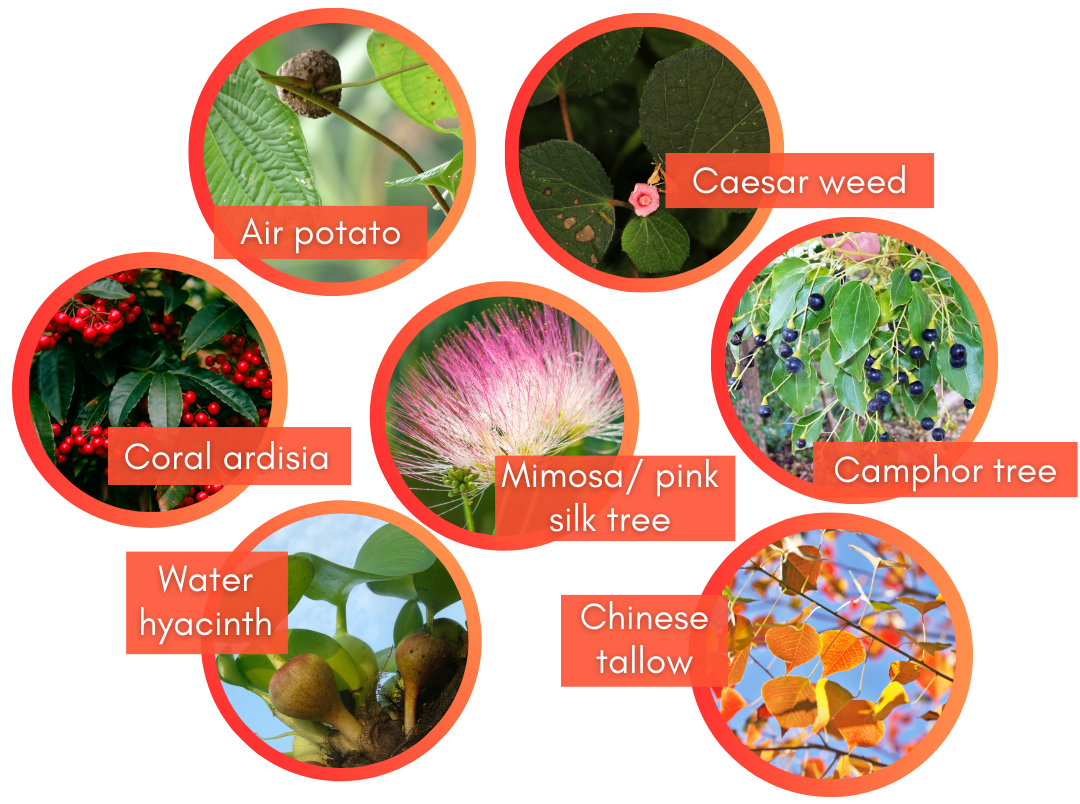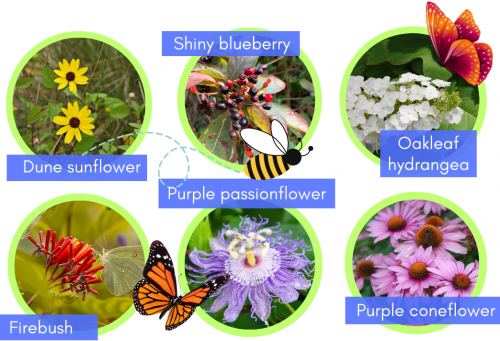Florida is uniquely vulnerable to invasive plants and animals due to the subtropical climate, a large influx of visitors each year, a multitude of international ports, and popular exotic trading markets. Invasive plants in Florida make up 33% of the total plant biomass in the state, despite accounting for just 4% of plant species. As a result, $45 million are spent each year to suppress invasive plant species across the state.
Florida is home to a rich variety of distinct ecosystems and wildlife, including 230 endemic plant species and 269 endemic animal species, more than almost any other state. The damage caused by invasive species, plants and animals alike, is second only to the destruction of habitat through human development.
The good news is, you can help to keep invasive plants in check– even just in your backyard! Keep reading to learn more about the characteristics of an invasive plant, how to remove them from your backyard, and what native plants you can plant instead!
Learn the Difference
Native vs. Nonnative
- A native species is indigenous to the area it inhabits, and has adapted to living within that ecosystem without human intervention.
- Species that are native to an area can behave aggressively if they begin to overpopulate and crowd out other native species.
- A nonnative species (sometimes called “exotic”) is one that has been introduced to an area that it did not originate from. While nonative species are not from the introduced habitat, they may react well to the conditions and become established.
- Nonnative species that do not outcompete native species may be considered “naturalized species.” This includes some plants that have been cultivated by people for a certain purpose over many years. For example, while the official state fruit of Florida is the orange, orange trees are actually not native to Florida, and are now considered a naturalized species.
- A plant or animal that is native to one area may act as an invasive nonnative species in another area, and vice versa!
Invasive vs. Non-invasive
- A non-invasive species is one that co-exists with other species in the area that it occupies, without crowding out or inhibiting their growth. In many cases, non-invasive species are beneficial to the environment in some way and interact with other non-invasive and native species to sustain the health of the ecosystem.
- An invasive species is one that spreads quickly, sometimes out of control, across the environment and overtakes native species. Since invasive species do not originate from the area, they often do not provide value to native insects and animals. By outcompeting native species that are necessary for a healthy ecosystem, invasive species can inflict significant economic and ecological damage.
Why Should You Remove Invasive Plants?
Invasive plants are incredibly damaging to Florida’s diverse natural ecosystems, and disrupt the delicate balance between the native flora and fauna. Even a small amount of invasive plants in your backyard can eventually overtake native species and become very unmanageable. An area overrun by invasive plants is less desirable for wildlife due to the lack of nutrient-rich native plants, and deters the establishment of pollinators, birds, and bats.
By taking the time to survey your own yard and making an effort to remove any invasive species, you are not only making your yard more welcoming to native plants and animals, but you are preventing the spread of invasive plants into neighboring yards, parks, and preserves. Plus, a flourishing backyard of native plants and animals is beautiful and rewarding!
Common Invasive Plants in Florida
 Category I nonnative plants listed by the Florida Invasive Species Council, meaning they are invasive to the point of altering native plant communities):
Category I nonnative plants listed by the Florida Invasive Species Council, meaning they are invasive to the point of altering native plant communities):
- Coral ardisia (Ardisia crenata)
- Caesar weed (Urena lobata)
- Chinese tallow (Triadica sebifera)
- Water hyacinth (Eichhornia crassipes)
- Air potato (Dioscorea bulbifera)
- Japanese climbing fern (Lygodium japonicum)
- Brazilian peppertree (Schinus terebinthifolia)
- Mimosa/pink silk tree (Albizia julibrissin)
- Camphor tree (Cinnamomum camphora)
How to Remove and Dispose of Invasive Plants
Hand-pulling
- Hand pulling is the most accessible form of invasive plant control, but can also be tiring. Make sure to:
- Pull from the base of the plant to dislodge the entire root. If the plant snaps and the root remains, it will likely be able to regrow later on.
- Pick up, contain, and dispose of any seeds or berries.
- Wear gloves if necessary.
Herbicide Use
- Larger or woodier plants may require herbicide application, but this also demands more research, preparation, and resources. For more information about what herbicides to use on the invasive plants you’re dealing with, and how to apply them safely, visit these pages:
- Before applying herbicides, make sure to:
- Check for nearby wetlands or waterways that could be contaminated by runoff. Herbicides can cause significant damage to aquatic ecosystems and native species. In these cases, opt for an herbicide that has been approved for use near water.
- Take the appropriate steps to protect yourself and others from the chemicals. Wear latex or rubber gloves, long sleeves and pants, and eye protection to avoid exposure.
Disposal
- Plants that are hand-pulled can be hung in the crooks of tree branches off the ground to allow the roots to air dry. Only use this method with plants that are unable to regrow from vegetative parts. Once dried out, plants can be left outside or disposed of in trash bags.
- The seeds, berries, and other viable parts of invasive plants should be thrown away in a tied off trash bag. This method can also be used for plants that cannot be air dried.
For more in depth information regarding disposable methods for invasive plants, reference this publication:
Beware of Invasive Hitchhikers!
Inspect and clean boots, tire treads, boats, and other equipment if you have entered an area where invasive plants are present. Seeds and plant fragments can easily “hitchhike” to other areas that may not yet be affected and establish themselves there. By checking beforehand, you can help prevent the spread of invasive plants!
Plant Native Species Instead!
Instead of planting invasives, use native plants! This is great not just for a beautiful garden, but also for a bustling wildlife habitat for pollinators (butterflies, bees, and hummingbirds!) who feed on native flowers, songbirds, bats, and more! Native plants also have lower water demands since they are adapted to the Florida environment, and require much less maintenance than nonnative species. There are plenty of attractive native plants that will make for a colorful, diverse, and fragrant yard. 
Some native plants that you can consider as an alternative to invasive plants are:
- Shiny blueberry (Vaccinium myrsinites)
- Dune sunflower (Helianthus debilis)
- Purple coneflower (Echinaecea purpurea)
- Blue porterweed (stachytarpheta jamaicensis)
- Atlantic St. John’s wort (Hypericum tenuifolium)
- Southern magnolia (magnolia grandiflora)
- Red maple (Acer rubrum)
- Persimmon (Diospyros virginiana)
- Firebush (Hamelia patens)
- Oakleaf hydrangea (Hygrangea quercifolia)
- Purple passion flower (Passiflora incarnata)
- American wisteria (Wisteria frutescens)
Get Involved!
In addition to clearing invasive plants in your own backyard, you can get involved in your community to help remove them from nature parks and public spaces!
- The annual Great Invader Rally in Gainesville, Florida brings hundreds of volunteers together to remove thousands of pounds of Coral ardisia all around the city! Follow the Facebook page for updates about when the next event will take place.
- Join the volunteer list for the Alachua Conservation Trust (ACT) to participate in events, including invasive species removal, occurring from September through May.
Information from UF IFAS, Florida Invasive Species Council, Nature Conservancy, US Forest Service, Florida Department of Environmental Protection, Alachua Conservation Trust, Lake County Department of Public Resources, Lilly Center for Lakes and Streams, and Florida Native Plant Society.